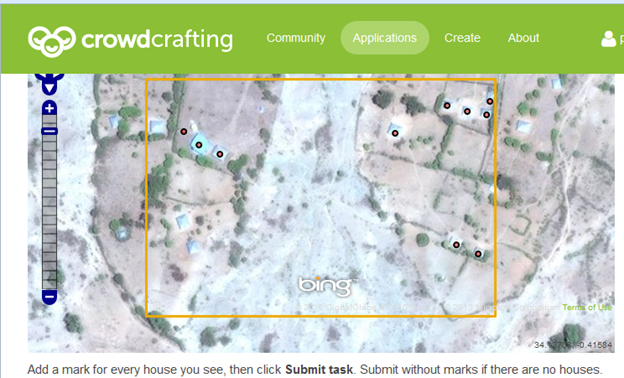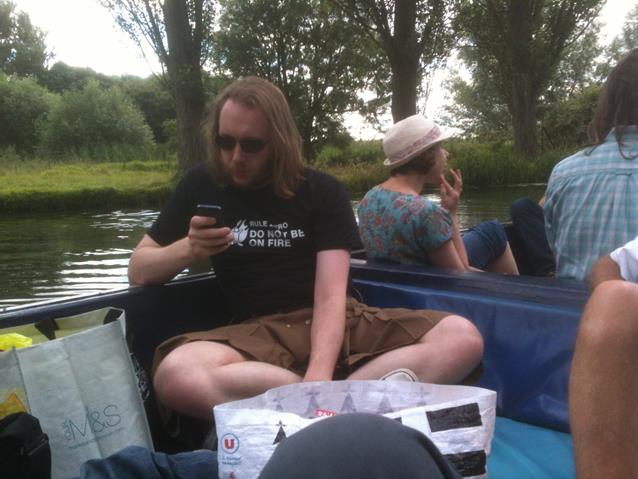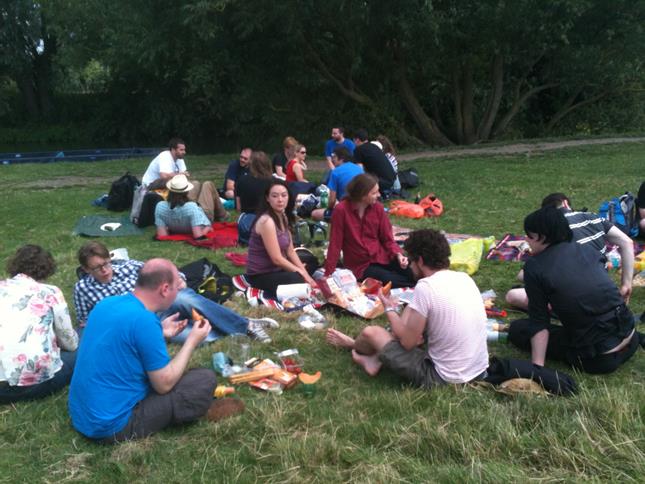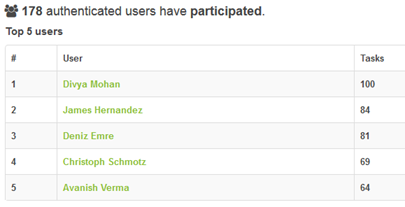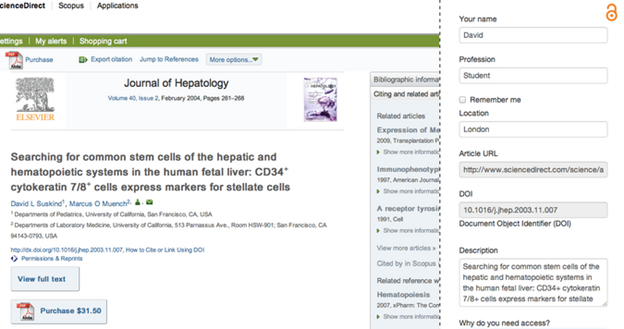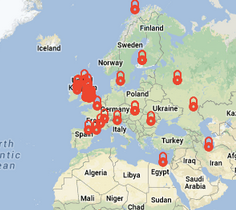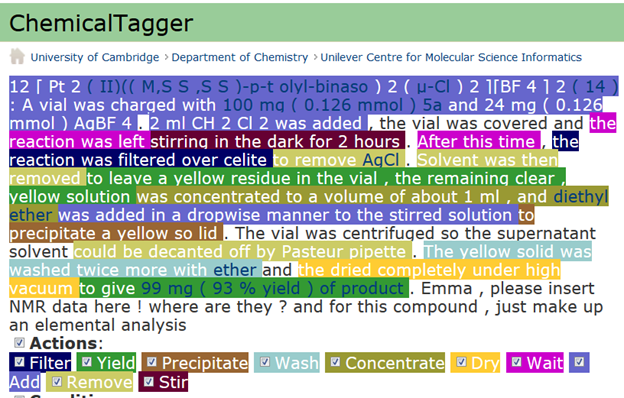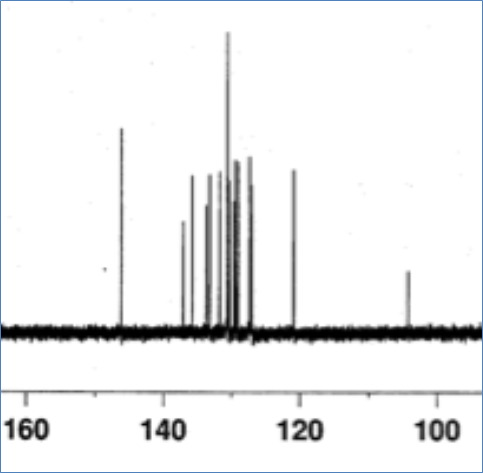I have been non-systematically looking at “open access” from major publishers, mainly initiated from their marketing with the #openaccess tag on Twitter. {I have a serious criticism of University libraries that they are not monitoring #openaccess compliance and that it’s left to a few individuals to highlight problems. The issues I highlight should have been identified by them, not me. I can only produce anecdotal evidence.] The sort of questions I ask myself and try to report are:
- What does the publisher offer as “open access”? This can vary from CC-BY (PLoS, BMC, eLife, etc. and Springer , Wiley) to “copyright the publisher, all rights reserved”.
- It’s the offering labelled as Open Access? On the masthead? On the paper?
- What are the re-use rights? In particular are particular groups charged additionally (I use the Rightslink service – normally a “Request Permissions” on the masthead).
- Are there obvious inequities for author or reader, re-user?
It can be very difficult to search for Open Access articles from a publisher. It should be trivial, but isn’t.
So I got the following tweet today:
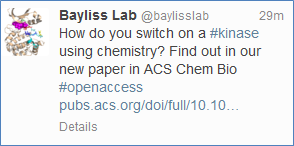
(You can follow this trail). This is the authors (not the publisher) advertising their paper. Nothing wrong with that except that when everyone does it the tag will be flooded (if it isn’t already). So I follow it to http://pubs.acs.org/doi/full/10.1021/cb400425t and get:
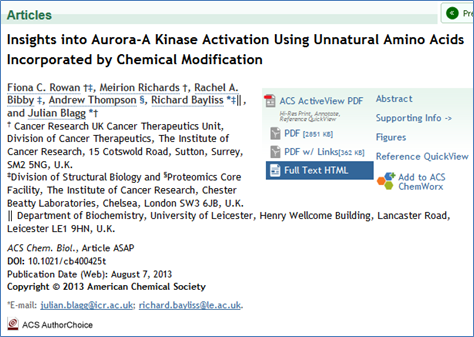
There is nothing saying this is “Open Access” to someone unfamiliar with ACS publications. The paper is © ACS so belongs-to-them. In fact the “ACS Author Choice” is a form of Open Access.
This post now covers what “Author Choice” means in detail. [BTW the ACS+RightsLink does allow the re-use of this article for teaching and dissertation without charge. Try it]
Let’s click ACS Author Choice: nothing happens – it’s not a link.
This is seriously unsatisfactory. If authors/funders have paid for Open Access it should be honoured on the page and on the manuscript. I’ve challenged the ACS on this 6 years ago (/pmr/2007/06/23/author-choice-in-chemistry-at-acs-and-elsewhere/ ), they’ve done nothing, so they are consciously making it obscure that this is an OA paper. I have to Google for ACS Author Choice (it’s easier than trying to navigate the journal pages) to get http://pubs.acs.org/userimages/ContentEditor/1218220609981/authorchoice_form.pdf and http://pubs.acs.org/page/policy/authorchoice/index.html . It costs 3000 USD unless you are a member of ACS or their scheme.
Option A: Standard ACS AuthorChoice
This AuthorChoice Open Access option is best for authors who choose to publish articles under the terms of a license from ACS that allows others the right to use the final published article (the Version of Record) in a variety of ways, including the creation of derivative works such as translations, for noncommercial purposes.
Note: When transferring copyright to the ACS under this option, you still retain all the permissions granted to you under the terms of your Journal Publishing Agreement with the Society.
-
Pricing and license information (Option A)
Option B: ACS AuthorChoice via the Creative Commons CC-BY-NC-ND License
This AuthorChoice Open Access option is offered for authors who prefer or must publish articles under the terms of a Creative Commons license that allows others the right to use the final published article (the Version of Record) only for non-commercial purposes, but not to modify or alter the published work. You also retain all the permissions granted to you under the terms of your Journal Publishing Agreement with ACS.
-
Pricing and license information (Option B)
Option C: ACS AuthorChoice via the Creative Commons CC-BY License
This AuthorChoice Open Access option is typically for authors who are required by their funding sponsors to publish articles under the terms of a Creative Commons license that allows others the right to use the final published article (the Version of Record) for commercial as well as non-commercial purposes and to modify the published work. You also retain all the permissions granted to you under the terms of your Journal Publishing Agreement with ACS.
-
Pricing and license information (Option C)
Note: Effective April 1, 2013, authors receiving funding from the Wellcome Trust and Research Councils UK (RCUK) are directed by their funding agency to publish using the CC-BY license.
As far as I can see there is no price differential between these (but this whole linkset is messy and complex to navigate).
Which option applies to the current document?
I have no idea. I assume it is the first because there is no mention of a licence. This isn’t good enough. If we look at the PDF there is not even any mention this is an “Author Choice” article let alone Open Access (of any sort). Follow http://pubs.acs.org/doi/pdf/10.1021/cb400425t . All you get is “Copyright American Chemical Society”.
It is not acceptable for a reputable publisher not to label its products clearly. The authors and their funders have paid for openness and clarity.
But I also criticize the University libraries strongly. It’s their job to manage copyright and licensing. They’ve done virtually nothing to make things clearer. And, worst of all, they haven’t challenged the publishers. Rather they simply take whatever the publishers offer and enforce it. (Prove me wrong with public examples, please).
As many publishers (including closed access ones) have shown, the simplest solution is simply to publish as CC-BY. It’s simple, it’s honest. It’s universally understood. Here we have the implication that CC-BY is a nuisance introduced by Wellcome and RCUK and wouldn’t we all be better off with CC-NC?
We wouldn’t. But the ACS would be significantly better off. Because they can control the Open Access material they receive and generate a third or even fourth income stream from it by controlling redistribution and re-use in the commercial sector (whatever that is).
